A) the demand for its product must be inelastic.
B) it can control both price and quantity sold.
C) it must reduce its price to sell more units.
D) it will always make a profit.
F) A) and C)
Correct Answer

verified
Correct Answer
verified
Multiple Choice
When a monopolistically competitive firm cuts its price to increase its sales,it experiences a loss in revenue due to the
A) substitution effect.
B) income effect.
C) price effect.
D) output effect.
F) B) and C)
Correct Answer

verified
Correct Answer
verified
True/False
When a monopolistically competitive firm breaks even in the long run,this is equivalent to earning a zero accounting profit.
B) False
Correct Answer

verified
Correct Answer
verified
Multiple Choice
Which of the following is not a characteristic of monopolistic competition?
A) There are many buyers and sellers.
B) There are low barriers to entry.
C) Average revenue is equal to price.
D) The products sold by all firms are identical.
F) A) and C)
Correct Answer

verified
Correct Answer
verified
Multiple Choice
Table 9-3
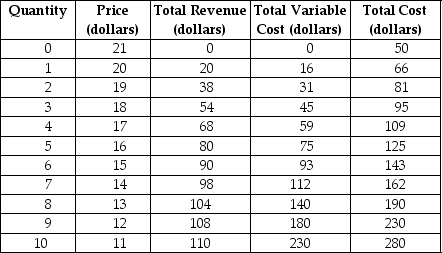 Table 9-3 shows the demand and cost schedules for a monopolistically competitive firm.
-Refer to Table 9-3.If this firm continues to produce,what is likely to happen to the product's price in the long run?
Table 9-3 shows the demand and cost schedules for a monopolistically competitive firm.
-Refer to Table 9-3.If this firm continues to produce,what is likely to happen to the product's price in the long run?
A) It will fall.
B) It will increase
C) It will remain constant.
D) It cannot be determined without information on its long-run demand curve.
F) All of the above
Correct Answer

verified
Correct Answer
verified
Multiple Choice
If a firm has excess capacity,it means
A) that the firm expends too much of its resources on advertising its product without seeing an appreciable increase in sales.
B) that the firm is not producing its minimum efficient scale of output.
C) that the firm's long-run average cost of producing a given quantity exceeds its short-run cost of producing that same quantity.
D) that the firm's quantity supplied exceeds its quantity demanded.
F) A) and D)
Correct Answer

verified
Correct Answer
verified
Multiple Choice
Figure 9-9  -Refer to Figure 9-9.Which of the graphs in the figure depicts a monopolistically competitive firm that is earning economic profits?
-Refer to Figure 9-9.Which of the graphs in the figure depicts a monopolistically competitive firm that is earning economic profits?
A) Panel A
B) Panel B
C) Panel C
D) Panel A and Panel B
F) A) and B)
Correct Answer

verified
Correct Answer
verified
Multiple Choice
A reason why there is more competition among restaurants than among large discount department stores is that restaurants
A) have to cater to a variety of consumer tastes while department stores do not.
B) unlike department stores, have to abide by government sanitation rules.
C) unlike department stores, do not have significant economies of scale.
D) have more elastic demand for their product compared to department stores.
F) B) and C)
Correct Answer

verified
Correct Answer
verified
True/False
A monopolistically competitive firm should lower its price if its marginal revenue exceeds its marginal cost.
B) False
Correct Answer

verified
Correct Answer
verified
Multiple Choice
Table 9-8 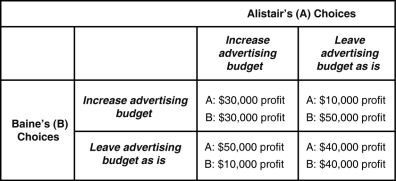 Firm A (Alistair's) and Firm B (Baine's) are the only firms selling luggage in the upscale city of Adelaide. Each firm must decide on whether to increase its advertising spending to compete for customers. If one firm increases its advertising budget but the other does not, then the firm with the higher advertising budget will increase its profit. Table 9-8 shows the payoff matrix for this advertising game.
-Refer to Table 9-8.What is the Nash equilibrium in this game?
Firm A (Alistair's) and Firm B (Baine's) are the only firms selling luggage in the upscale city of Adelaide. Each firm must decide on whether to increase its advertising spending to compete for customers. If one firm increases its advertising budget but the other does not, then the firm with the higher advertising budget will increase its profit. Table 9-8 shows the payoff matrix for this advertising game.
-Refer to Table 9-8.What is the Nash equilibrium in this game?
A) There is no Nash equilibrium.
B) Baine increases its advertising budget, but Alistair does not.
C) Alistair increases its advertising budget, but Baine does not.
D) Both Alistair and Baine increase their advertising budgets.
F) B) and D)
Correct Answer

verified
Correct Answer
verified
Multiple Choice
When new firms are encouraged to enter a monopolistically competitive market,
A) some existing firms must be earning economic profits.
B) they do so because there is insufficient product differentiation.
C) the demand curve facing an existing firm shifts to the right.
D) the marginal cost curve facing an existing firm shifts downwards.
F) A) and B)
Correct Answer

verified
Correct Answer
verified
Multiple Choice
Compared to a perfectly competitive firm,the demand curve facing a monopolistically competitive firm is
A) more elastic because there are many close substitutes for the product of a monopolistically competitive firm.
B) less elastic because monopolistically competitive firms produce similar, but not identical, products.
C) just as elastic because there are many sellers in both markets.
D) more elastic because, in the long run, the demand curve is tangent to the firm's average total cost curve.
F) All of the above
Correct Answer

verified
Correct Answer
verified
True/False
Unlike a perfectly competitive firm,a monopolistic competitor does not have a short-run shutdown point.
B) False
Correct Answer

verified
Correct Answer
verified
Multiple Choice
Figure 9-7 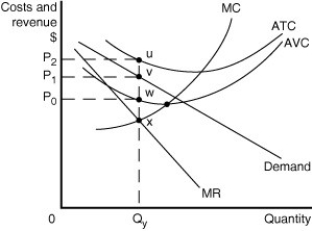 Figure 9-7 shows short-run cost and demand curves for a monopolistically competitive firm in the footwear market.
-Refer to Figure 9-7.Which of the following is the area that represents the profit or loss experienced by the firm?
Figure 9-7 shows short-run cost and demand curves for a monopolistically competitive firm in the footwear market.
-Refer to Figure 9-7.Which of the following is the area that represents the profit or loss experienced by the firm?
A) A loss represented by the rectangle P2uvP1.
B) A loss represented by the rectangle P2uwP0.
C) A loss represented by the rectangle P1vwP0.
D) An accounting profit equal to P1vwP0.
F) A) and D)
Correct Answer

verified
Correct Answer
verified
Multiple Choice
Table 9-3
 Table 9-3 shows the demand and cost schedules for a monopolistically competitive firm.
-Refer to Table 9-3.What are the profit-maximising/loss-minimising output level and price?
Table 9-3 shows the demand and cost schedules for a monopolistically competitive firm.
-Refer to Table 9-3.What are the profit-maximising/loss-minimising output level and price?
A) Q = 0 (firm should not produce)
B) Q = 3; P = $18
C) Q = 4; P = $17
D) Q = 5; P = $16
F) A) and D)
Correct Answer

verified
Correct Answer
verified
Multiple Choice
A monopolistically competitive firm that is profitable in the short run will face competition that will eventually eliminate the firm's profits in the long run.But the firm can stave off competition and continue to earn economic profits if
A) it can successfully sue its competitors for copyright infringement.
B) it can move to another country where there is less competition.
C) it can lobby the government to establish a price floor for its product.
D) it can find new ways to differentiate its product.
F) B) and C)
Correct Answer

verified
Correct Answer
verified
Multiple Choice
Figure 9-18 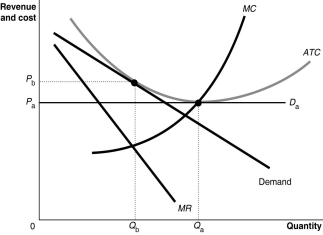 -Refer to Figure 9-18.Which of the following statements is true?
-Refer to Figure 9-18.Which of the following statements is true?
A) Da represents the long-run demand curve facing a monopolistic competitor in a constant-cost industry while Db depicts the demand curve in the short run.
B) Da represents the long-run demand curve facing a monopolistic competitor in a constant-cost industry while Db depicts the long-run demand curve in an increasing-cost industry.
C) Da represents the long-run demand curve facing a perfect competitor while Db depicts the long-run demand curve facing a monopolistic competitor.
D) Da represents the long-run supply curve in a perfectly competitive, constant-cost industry while Db depicts the long-run demand curve facing a monopolistic competitor in a decreasing-cost industry.
F) C) and D)
Correct Answer

verified
Correct Answer
verified
True/False
Productive efficiency does not hold for a profit-maximising,monopolistically competitive firm in the long-run equilibrium because the firm operates along the diseconomies-of-scale region of its average total cost curve.
B) False
Correct Answer

verified
Correct Answer
verified
Essay
Figure 9-11 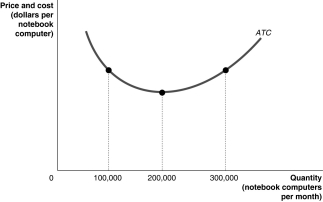 -Refer to Figure 9-11.Suppose the graph represents the relationship between the average total cost of producing notebook computers and the quantity of notebook computers produced by Dell.On a graph,illustrate the demand,MR,MC,and ATC curves which would represent Dell maximising profits at a quantity of 100 000 per month and identify the area on the graph which represents the profit.
-Refer to Figure 9-11.Suppose the graph represents the relationship between the average total cost of producing notebook computers and the quantity of notebook computers produced by Dell.On a graph,illustrate the demand,MR,MC,and ATC curves which would represent Dell maximising profits at a quantity of 100 000 per month and identify the area on the graph which represents the profit.
Correct Answer

verified
Correct Answer
verified
Multiple Choice
Which of the following statements is true?
A) The marginal revenue of a monopolistically competitive firm will be positive at high prices and negative at low prices.
B) Because the demand curve for a monopolistically competitive firm is downward sloping, its marginal revenue will be negative.
C) The marginal revenue of a monopolistically competitive firm will always be positive.
D) The marginal revenue of a monopolistically competitive firm will be positive at low prices and negative at high prices.
F) A) and C)
Correct Answer

verified
Correct Answer
verified
Showing 281 - 300 of 351
Related Exams